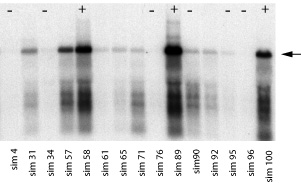![]()
Regulation of activity
Our long-term goal is to understand what regulates the activity (retrotransposition) of the R1 and R2 transposable elements. Considerable progress has been made recently because stable lines of Drosophila have been found to have very different rates of R2 and R1 retrotransposition. In the case of R2, the retrotransposition rate correlates with the level of R2 transcripts that can be detected on RNA blots (see Figure). Those strains with the highest levels of R2 transcripts average about one new insertion for every 3 progeny. Lines with the lowest levels of R2 transcripts have no detectable new insertions after many generations. The retrotranspositions occur during the development of both the male and the female germ lines, predominately during the period when the primordial germ cells are undergoing their final mitotic divisions before meiosis. The retrotransposition activity can have major affects on the locus, not only by simply inactivating units but also by generating large deletions involving many rDNA units within the locus.

The level of R2 transcripts in 16 lines of D. simulans obtained from one population. The arrow at left corresponds to full-length R2 transcripts. The R2 retrotransposition activity of each line is indicated by a (+), highest levels of activity, or a (-), lowest levels of activity.
Drosophila lines with active or only inactive R2 elements are stable over many generations which will allow us to genetically dissect the regulation. Control over the rates of RNA transcription and retrotransposition appears to lie predominantly within the rDNA locus itself. When a chromosome with an rDNA locus containing “active” R2 elements is paired with a chromosome with a rDNA locus containing “inactive” R2 elements (i.e. heterozygous flies), only the rDNA locus with the inactive elements is expressed. This regulation appears similar to a phenomenon observed in both plants and animals and is referred to as nucleolar dominance. We are currently attempting to identify the epigenetic factors that are common to those rDNA loci that contain active R2 elements but not found in those loci with inactive elements. The chromatin structure of the units and/or the distribution of inserted units in the locus appear to be important factors rather than the number of R2 elements within the locus.
Home | Research overview | Mech of retrotransposition | Evolution of the rDNA locus |Regulation of activity| Publications | Members | |